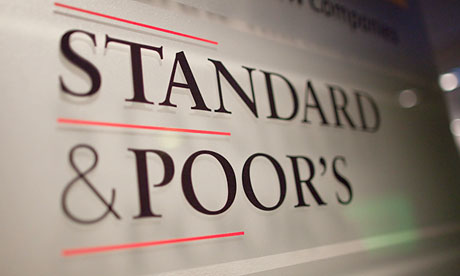July, 8, 2014

Overview
-- The rating on Sri Lanka balances external, fiscal, and institutional constraints with a strong economic growth profile, the improving financial performances of public enterprises, and declining inflation.
-- We are affirming our 'B+' long-term and 'B' short-term sovereign credit ratings on Sri Lanka.
-- The stable outlook reflects our expectation that Sri Lanka's per capita real GDP will grow more than 5.5% in the next few years and the government's fiscal profile could improve over the next 12 months.
Rating Action
On July 8, 2014, Standard & Poor's Ratings Services affirmed its 'B+' long-term and 'B' short-term sovereign credit ratings on the Democratic Socialist Republic of Sri Lanka. The outlook remains stable. Our transfer and convertibility risk assessment on Sri Lanka is unchanged at 'B+'.
Rationale
The sovereign rating on Sri Lanka reflects the country's relatively low levels of wealth, improving but still moderately weak external liquidity, and a sizable government debt and interest burden. In addition, some of the country's political institutions lack extensive checks and balances, posing risks to Sri Lanka's institutional and governance effectiveness.
These rating constraints weigh against the country's robust growth prospects. The factors that help Sri Lanka's growth are government investment, including measures to reconstruct the northern districts, the improving financial performance of public enterprises, increasing tourist arrivals, and declining inflation, which we expect to remain in the single digits.
Although we expect Sri Lanka's external liquidity to improve in the next few years, it remains exposed to international liquidity conditions. Standard & Poor's projects Sri Lanka's gross external financing needs in 2014-2017 will average 106% of current account receipts (CAR) plus usable reserves, with an improving trend. We also forecast that the country's external debt--net of official reserves and financial sector external assets-will approximate 125% of CAR this year. In our view, external net debt stock measure will gradually decline to below 110% by 2017.
We expect Sri Lanka's gross international reserves to remain at three months' coverage of current account payments in December 2014, similar to 2012 and 2013 levels. Despite increasing remittances by overseas Sri Lankans and rapidly increasing earnings from tourism, the expansion of current account payments will match the growth in foreign currency reserves.
Fundamental fiscal weaknesses remain although the government's fiscal metrics have improved over the past four years. We project annual growth in general government debt to average 6.7% of GDP for 2014-2017. In conjunction with robust nominal GDP growth and some fiscal consolidation, we expect net general government debt to decline below 70% of GDP at year-end 2016 from 78% in 2013. The rate of decline could slow, however, should the rupee depreciate further against major currencies, as 44% of government debt is denominated in foreign currencies. In addition, we project that the attendant interest burden will comprise about a third of government revenue through 2017. The debt service burden is thus among the highest for the 130 sovereign governments we rate.
The Sri Lankan government has made marked progress in turning Ceylon Electricity Board to a profit and reducing the losses in Ceylon Petroleum Corp., two of the most significant state-owned entities. As a result, we estimate aggregated debts of the state-owned entities to have declined in 2013. These entities, however, still represent a sizable portion of claims in the domestic financial system, and therefore remain contingent fiscal risks to the government.
We have incorporated Sri Lanka's favorable growth prospects in our projection. We expect the country will most likely maintain per capita real GDP growth of close to 6% per year in the next few years. We believe stronger growth may be possible if the business environment improves and net foreign direct investment rises above its current pace of about 1.5% of GDP. However, Sri Lanka's high growth could raise the risk of economic overheating because of capacity constraints.
After completion of the International Monetary Fund's Standby Loan Program in July 2012, the country agreed with the IMF for "Post-Program Monitoring." We expect Sri Lanka to be able to secure new external liquidity support from the IMF or bilateral sources if the need arises.
Outlook
The stable outlook reflects our view that growth prospects for Sri Lanka's per capita real GDP will be more than 5.5% in the next few years and the government's fiscal profile could improve over the next 12 months.
We may raise the rating if Sri Lanka's external and fiscal indicators improve faster than we project, or if we believe the strength of Sri Lanka's institutions and governance practices are on a significant and sustained improving trend.
Conversely, we may lower the rating if, contrary to our expectation, the country's external liquidity deteriorates or if Sri Lanka's growth and fiscal consolidation prospects worsen significantly.
Video Story